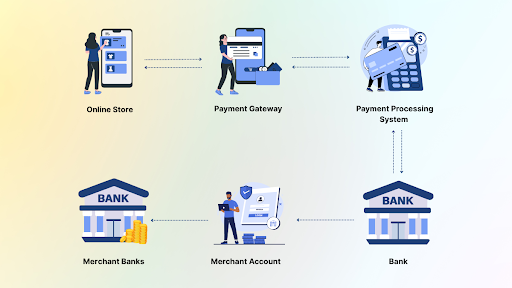The Evolution of Payment Gateways
Payment gateways are crucial in facilitating seamless transactions across various platforms. What is a Payment Gateway? It serves as a bridge between merchants and customers, enabling efficient processing of payments in both online and offline environments. As the landscape evolves, these gateways are transforming into comprehensive solutions that not only handle payments but also provide valuable insights and support for businesses aiming to enhance their customer experience. Embracing this shift toward omnichannel capabilities is essential for enterprises seeking to remain competitive in an increasingly interconnected marketplace.
Why This Shift Matters
The global payment gateway market was valued at $35.17 billion in 2024 and is projected to touch $152.26 billion by 2032, growing at 20% CAGR.
- 89% of companies with strong omnichannel engagement retain customers better than those with single-channel strategies.
- Retail shoppers in 2025 use nearly six different touchpoints before making a purchase, compared to just two touchpoints 15 years ago.
The message is clear: businesses that fail to provide unified payment experiences risk losing customers to competitors who do.
What is a Payment Gateway?
A payment gateway is a digital service that securely processes payments between a customer and a business. It works behind the scenes to ensure every transaction is authorized, encrypted, and completed within seconds.
Real-Time Example
Imagine a customer buying shoes online:
- They add the shoes to the cart and click “Pay Now.”
- The payment gateway opens a secure page where the customer enters card details or selects UPI.
- The gateway encrypts the data and checks for possible fraud using tools like IP tracking or AI models.
- The request is sent to the acquiring bank, then to the card network (Visa/Mastercard/RuPay), and finally to the issuing bank for approval.
- The bank approves or declines the payment, and the result is instantly shared with both the customer and the merchant.
- If approved, money is transferred from the customer’s bank account to the merchant’s account within a few hours or days.
- The same gateway can also process an offline transaction, for example, when the same customer taps their card on a store POS terminal.
This is why payment gateways are often called the “invisible cashiers” of the digital world.
The Limitations of Traditional Payment Gateways
Traditional gateways, built mainly for online card payments, are no longer enough. Customers now expect choice, speed, and security across all channels.
Key Challenges
- High abandonment rates: 70% of shopping carts are abandoned globally, often due to poor payment experiences.
- Limited options: 54% of shoppers quit if only credit/debit cards are offered.
- Trust issues: 25% abandon checkout when the payment gateway looks untrustworthy.
- Failed payments: Globally, 10–15% of card payments fail; in emerging markets, this can rise to 40%.
Operational Problems
- Multiple intermediaries make reconciliation complex.
- Transaction fees of 2–3% eat into margins.
- Settlement can take days, slowing cash flow.
- Reporting is siloed across online and offline channels.
Clearly, businesses need something stronger – an omnichannel gateway.
The Benefits of an Omnichannel Payment Gateway
An omnichannel payment gateway unifies online and offline payments into a single platform. Whether the customer is paying in-store, online, via mobile app, or through recurring subscriptions, the experience feels seamless.
Customer Benefits
- Unified experience: Customers can start a purchase online and complete it in-store (or vice versa).
- More choices: From UPI to BNPL (Buy Now, Pay Later), all payment modes are supported.
- Higher trust: Consistent branding and secure transactions reduce drop-offs.
Business Benefits
- Increased sales: Businesses using 3+ channels see a 494% higher order rate compared to single-channel sales.
- Better conversions: BNPL increases conversion by 25%, while smart routing boosts success rates.
- Efficiency gains: Unified reconciliation improves operations by 20%.
- Fraud protection: AI-driven gateways cut chargeback rates by up to 55%.
- Revenue growth: Companies with strong omnichannel strategies grow 9.5% annually, compared to 3.4% for others.
Where Payment Gateways Create Impact
Retail & E-commerce
- Multichannel customers spend 4x more than in-store only and 10x more than online-only customers.
- During the pandemic, online orders fulfilled through in-store pickup grew by 208%.
- 67% of shoppers expect the option to buy online and pick up in-store.
Education
- Schools need flexible tools like UPI Autopay, split settlements, and bulk payouts for fee collection.
- Integration with ERP systems automates invoicing and reconciliation.
- Parent-friendly dashboards with itemized receipts improve trust.
BFSI (Banking & Financial Services)
- Banks and NBFCs require real-time collections and repayments.
- Tokenization enables secure recurring payments.
- Instant settlements improve liquidity and customer satisfaction.
Government Services
- Citizens expect to pay taxes and fees both online and offline.
- Governments need 24/7 payment availability and high-volume capacity.
- Unified gateways reduce manual reconciliation and speed up fund allocation.
The Future of Payment Gateways: Acquiring Meets Issuance
Payment gateways are no longer just about collecting money. They are becoming enterprise platforms that connect both the acquiring (merchant side) and issuing (customer side).
Tech Trends Shaping the Future
- Tokenization: By 2025, 80% of enterprises will use tokenization, reducing fraud by 38%.
- Real-time payments: Account-to-account (A2A) payments are projected to hit $5.7 trillion by 2029, powered by networks like UPI (India), FedNow (US), and PIX (Brazil).
- AI & smart routing: AI-driven gateways will detect fraud in milliseconds and route payments through the most reliable channels.
- CBDCs (Central Bank Digital Currencies): With 134 countries exploring CBDCs, gateways must be ready to handle digital currencies like India’s Digital Rupee.
Conclusion: The Time to Go Omnichannel is Now
Payment gateways have come a long way, from simply processing card payments to powering entire ecosystems of online + offline transactions.
For enterprises, the choice is no longer about whether to adopt an omnichannel gateway, but when. Those who act early will gain:
- Higher customer retention
- Better revenue growth
- Stronger compliance and security
In the future, payment gateways won’t just be technology providers. They will be strategic growth partners helping businesses scale across markets, industries, and customer journeys.
Frequently Asked Questions About Payment Gateways
What is a payment gateway?
A payment gateway is a secure technology that connects a business with banks and payment networks. It ensures that money moves safely from a customer’s account to the merchant’s account during an online or offline transaction.
Is UPI a payment gateway?
No. UPI (Unified Payments Interface) is a real-time payment system developed by NPCI that enables instant money transfers between bank accounts. A payment gateway, on the other hand, is the infrastructure that connects merchants to UPI (and other modes like cards and wallets) so customers can pay securely.
Which payment gateway is used in India?
India has multiple payment gateways. Some of the popular ones include Razorpay, Cashfree, PayU, and BillDesk. Global players like Stripe and PayPal also operate in India. Many businesses also integrate with omnichannel gateways that support UPI, cards, net banking, and wallets together.
Which is the best payment gateway with UPI?
The “best Payment gateway” depends on the business type and transaction volume. A strong gateway should offer:
• High UPI success rates
• Smart routing for fewer failures
• Secure tokenization for repeat payments
• Easy reconciliation and settlement
Enterprises often prefer omnichannel gateways that combine UPI with other payment methods under one system.
How does a payment gateway work step by step?
1. Customer enters payment details (card/UPI/net banking).
2. Gateway encrypts the data and sends it to the acquiring bank.
3. The request is routed through card networks (Visa/Mastercard/RuPay) or UPI rails.
4. Issuing bank verifies funds and approves/declines the request.
5. Gateway shares the status with the merchant & customer instantly.
6. Settlement happens within hours to a few days.
What are the types of payment gateways?
• Hosted Gateways: Customers are redirected to the provider’s page (e.g., PayPal).
• Self-Hosted Gateways: Payment data is collected on the merchant’s site before being sent securely.
• API-Integrated Gateways: Direct integration into websites or apps with custom checkout flows.
• Omnichannel Gateways: Cover both online and offline payments across multiple channels.
What are the charges for using a payment gateway?
Charges vary by provider and payment type:
• Credit/Debit cards: 1.5%–3% per transaction
• UPI: Often zero MDR for P2P, but small charges may apply for enterprises
• Wallets/Net Banking: 1%–2% per transaction
Some providers also charge a setup fee or annual maintenance fee.
How secure is a payment gateway?
Payment gateways follow strict compliance standards like PCI DSS and use technologies like SSL encryption, tokenization, and fraud detection tools. A reliable gateway ensures customer data is safe and reduces fraud risks.
What is the difference between a payment gateway and a payment processor?
• Payment Gateway: Collects and encrypts customer details during checkout.
• Payment Processor: Handles the actual movement of funds between the customer’s and merchant’s banks.
Most modern providers bundle both into one seamless solution.
Why do some payments fail on a gateway?
Common reasons include:
• Insufficient balance
• Incorrect card or UPI details
• Issuing bank downtime
• Network errors during the transaction
• Fraud checks blocking unusual payments
• Smart routing and omnichannel platforms help reduce failure rates.




